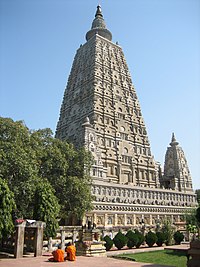মহাবোধি মন্দিৰ
| বুদ্ধগয়াৰ মহাবোধি মন্দিৰ | |
|---|---|
| বিশ্ব ঐতিহ্য ক্ষেত্ৰত তালিকাভুক্ত হিচাপে নাম | |
 বুদ্ধগয়াৰ মহাবোধি মন্দিৰ | |
| দেশ | |
| ধৰণ | সাংস্কৃতিক |
| মাপকাঠি | (i), (ii), (iii), (iv), (vi) |
| উদ্ধৃতি | ১০৫৬ |
| ইউনেস্কোৰ দ্বাৰা শ্ৰেণীবদ্ধ অঞ্চল | এছিয়া-পেছিফিক |
| স্থানাংক | 24°42′N 85°00′E / 24.7°N 85.0°Eস্থানাংক: 24°42′N 85°00′E / 24.7°N 85.0°E |
| অভিলিখনৰ ইতিহাস | |
| অভিলিখন | ২০০২ (২৬তম অধিবেশন) |
মহাবোধি মন্দিৰ (সংস্কৃত: महाबोधि मंदिर) বুদ্ধগয়াত অৱস্থিত এটা বৌদ্ধ মন্দিৰ। ইয়াতেই সিদ্ধাৰ্থ গৌতমে বুদ্ধত্ব লাভ কৰিছিল। বোধগয়া ভাৰতৰ বিহাৰ ৰাজ্যৰ ৰাজধানী পাটনাৰ পৰা 96 km (60 মাইল) দূৰত অৱস্থিত। মন্দিৰৰ পশ্চিম দিশে পবিত্ৰ বোধিবৃক্ষজোপা আছে। পালিশাস্ত্ৰত এই গছডালৰ নাম বোধিমণ্ড হিচাপে উল্লেখ আছে।[1] ইয়াত থকা মঠটোৰ নাম বোধিমণ্ড বিহাৰ। মন্দিৰৰ উচ্চতম শীৰ্ষটোৰ উচ্চতা ৫৫ মিটাৰ (180 ফুট)।
বুদ্ধগয়াৰ মহাবোধি মন্দিৰ প্ৰাংগন ৪.৮৬ হেক্টৰ অঞ্চল জুৰি প্ৰসাৰিত হৈ আছে। ই ইউনেস্কোৰ বিশ্ব ঐতিহ্য তালিকাৰ (i) বিভাগত বিশেষ সাংস্কৃতিক আৰু পুৰাতাত্বিক গুৰুত্বসম্পন্ন স্থান। মহামতি অশোকে খ্ৰীষ্টপূৰ্ব তৃতীয় শতাব্দীত মন্দিৰৰ পশ্চিমত অৱস্থিত বোধি বৃক্ষটিক (Ficus religiosa) কেন্দ্ৰ কৰি এই মন্দিৰ নিৰ্মাণ কৰিছিল যদিও বৰ্তমানৰ মন্দিৰটো খ্ৰীষ্টীয় পঞ্চম আৰু ষষ্ঠ শতাব্দীৰ মধ্যবৰ্তী সময়ত নিৰ্মিত। কথিত আছে, খ্ৰীষ্টপূৰ্ব ৫৩১ত ৩৫ বছৰ বয়সত সিদ্ধাৰ্থ গৌতমে ইয়াতেই বোধি বা বুদ্ধত্ব লাভ কৰিছিল। তাৰপাছত তেখেতে বৌদ্ধ ধৰ্ম প্ৰচাৰ আৰম্ভ কৰিছিল। সেই বাবে বৌদ্ধধৰ্মৰ এই অঞ্চলটো অত্যন্ত পবিত্ৰ জ্ঞান কৰা হয়। পাছৰ বহু শতাব্দীকাল ধৰি এই মন্দিৰটো বৌদ্ধদেৱৰ সৰ্বোচ্চ মৰ্যাদাসম্পন্ন উপাসনা কেন্দ্ৰ হিচাবে চিহ্নিত হৈ আহিছে। বিশ্বৰ ভিন্ন প্ৰান্তৰৰ পৰা বৌদ্ধধৰ্মৰ লোকসকল ইয়ালৈ তীৰ্থ কৰিবলৈ আহে। ৫০ মিটাৰ উচ্চ এই মন্দিৰটো ভাৰতীয় স্থাপত্যশৈলীত নিৰ্মিত। ই "ভাৰতৰ সুবৰ্ণ যুগ" নামে পৰিচিত গুপ্ত যুগত নিৰ্মিত ভাৰত উপমহাদেশৰ প্ৰাচীনতম মন্দিৰ। সম্ৰাট অশোকৰ সময়ৰ (খ্ৰীষ্টপূৰ্ব তৃতীয় শতাব্দী) মন্দিৰৰ সূক্ষাগ্ৰ, ক্ষুদ্ৰ স্তম্ভশ্ৰেণী মন্দিৰ প্ৰাংগনৰ অভ্যন্তৰস্থ পুৰাতত্ত্ব সংগ্ৰহালয়ত সুৰক্ষিত আছে।[2][3]
তথ্য সংগ্ৰহ
[সম্পাদনা কৰক]- ↑ In Pali, using Romanized diacritic marks, the word is spelled bodhimaṇḍa. In the Pali Canon, this term is found throughout the Buddhavamsa and, in one place, in the Jataka (Ja iv.238). Horner (2000) translates bodhimaṇḍa as "the dais of the Tree of Awakening" (e.g., pp. 15 v. 65, 25 v. 183, passim).
- ↑ "Mahabodhi Temple Complex at Bodh Gaya". UNESCO. http://whc.unesco.org/en/list/1056। আহৰণ কৰা হৈছে: 2010-10-03.
- ↑ "Mahabodhi Temple (India) No.1056rev". UNESCO. http://whc.unesco.org/archive/advisory_body_evaluation/1056rev.pdf। আহৰণ কৰা হৈছে: 2010-10-03.
বাহ্যিক সংযোগ
[সম্পাদনা কৰক] ৱিকিমিডিয়া কমন্সত মহাবোধি মন্দিৰ সম্পৰ্কীয় মিডিয়া ফাইল।
ৱিকিমিডিয়া কমন্সত মহাবোধি মন্দিৰ সম্পৰ্কীয় মিডিয়া ফাইল।- Land Enlightenment of the Buddha
- Bodhgaya News Archived 2008-03-23 at the Wayback Machine
- UNESCO World Heritage
- The Bodh Gaya temple controversy Archived 2007-09-30 at the Wayback Machine
| ||||||||||||||||||||||
Text is available under the CC BY-SA 4.0 license; additional terms may apply.
Images, videos and audio are available under their respective licenses.

